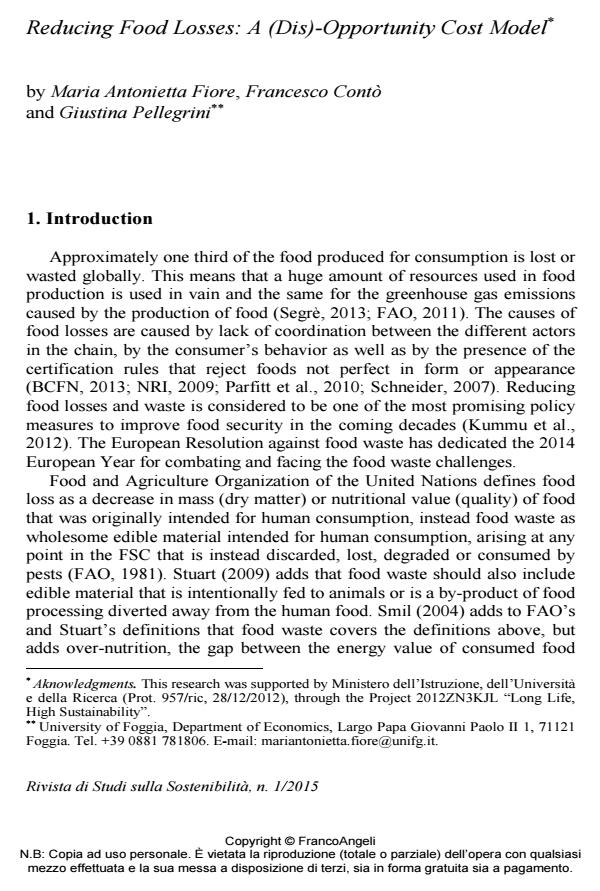Reducing Food Losses: A (Dis)-Opportunity Cost Model
Titolo Rivista RIVISTA DI STUDI SULLA SOSTENIBILITA'
Autori/Curatori Mariantonietta Fiore, Francesco Contò, Giustina Pellegrini
Anno di pubblicazione 2015 Fascicolo 2015/1
Lingua Inglese Numero pagine 16 P. 151-166 Dimensione file 242 KB
DOI 10.3280/RISS2015-001010
Il DOI è il codice a barre della proprietà intellettuale: per saperne di più
clicca qui
Qui sotto puoi vedere in anteprima la prima pagina di questo articolo.
Se questo articolo ti interessa, lo puoi acquistare (e scaricare in formato pdf) seguendo le facili indicazioni per acquistare il download credit. Acquista Download Credits per scaricare questo Articolo in formato PDF

FrancoAngeli è membro della Publishers International Linking Association, Inc (PILA)associazione indipendente e non profit per facilitare (attraverso i servizi tecnologici implementati da CrossRef.org) l’accesso degli studiosi ai contenuti digitali nelle pubblicazioni professionali e scientifiche
A huge amount of resources used in food production is lost or wasted globally and the same for the greenhouse gas emissions caused by the production of food. A plethora of methodologies to assess economic, environmental and social impacts stands out. The aim of this paper is to analyze the social impacts of food losses along the food chain: the methodology is based on the elaboration of a disopportunity cost taking into account food waste and losses Kcals and Kcals/required per day (to cope with the energy expenditure), U.A.A. (Utilized Agricultural Area) cost. Findings are aimed at highlighting how the food looses reduction is crucial for an intra-generational equity.
Una grande quantità di risorse utilizzate nella produzione alimentare è sprecata inutilmente e persa a livello globale: le stesse considerazioni possono essere fatte per le emissioni di gas serra derivanti dalla produzione di alimenti. Esistono una pletora di metodologie per valutare gli impatti economici, ambientali e sociali di tali perdite. L’obiettivo di questo lavoro è analizzare l’impatto economico-sociale delle perdite alimentari lungo la catena alimentare: la metodologia si basa sull’elaborazione di un modello di costo (dis)-opportunità, tenendo conto delle Kcal dei rifiuti, delle Kcal pro die (necessarie per affrontare il dispendio energetico) e del costo S.A.U. I risultati evidenziano come la riduzione delle perdite alimentari sia cruciale per una equità intragenerazionale.
Parole chiave:Perdita alimentare, rifiuto alimentare, impatto economico-sociale, costo (dis)-opportunità, sostenibilità, equità intragenerazionale
- Grape residue flour as an antioxidant and fiber source in beef meatballs Larissa Christine Tuffi, Daniel Angelo Longhi, Jéssica Carvalho Hernandes, Paulo Cézar Gregório, Carlos Eduardo Rocha Garcia, in British Food Journal /2021 pp.2831
DOI: 10.1108/BFJ-12-2020-1152 - Hidden flows assessment in the agri-food sector: evidence from the Italian beef system Vera Amicarelli, Mariantonietta Fiore, Christian Bux, in British Food Journal /2021 pp.384
DOI: 10.1108/BFJ-05-2021-0547 - A Worldwide Hotspot Analysis on Food Loss and Waste, Associated Greenhouse Gas Emissions, and Protein Losses Xuezhen Guo, Jan Broeze, Jim J. Groot, Heike Axmann, Martijntje Vollebregt, in Sustainability /2020 pp.7488
DOI: 10.3390/su12187488 - Green metamorphoses: agriculture, food, ecology M. Fiore, G. Pellegrini, F. Conto, pp.225 (DOI:10.3920/978-90-8686-898-8_18)
- Food Loss and Waste, a global responsibility?! Nino Adamashvili, Filomena Chiara, Mariantonietta Fiore, in ECONOMIA AGRO-ALIMENTARE 3/2020 pp.825
DOI: 10.3280/ECAG2019-003014 - The Role of Communication Tools in the Knowledge and Diffusion of Sustainable Development Goals: Insights from Multiple Correspondence Analysis Maria Rosaria Maschio, Alessia Spada, Mariantonietta Fiore, in Sustainability /2024 pp.10868
DOI: 10.3390/su162410868
Mariantonietta Fiore, Francesco Contò, Giustina Pellegrini, Reducing Food Losses: A (Dis)-Opportunity Cost Model in "RIVISTA DI STUDI SULLA SOSTENIBILITA'" 1/2015, pp 151-166, DOI: 10.3280/RISS2015-001010